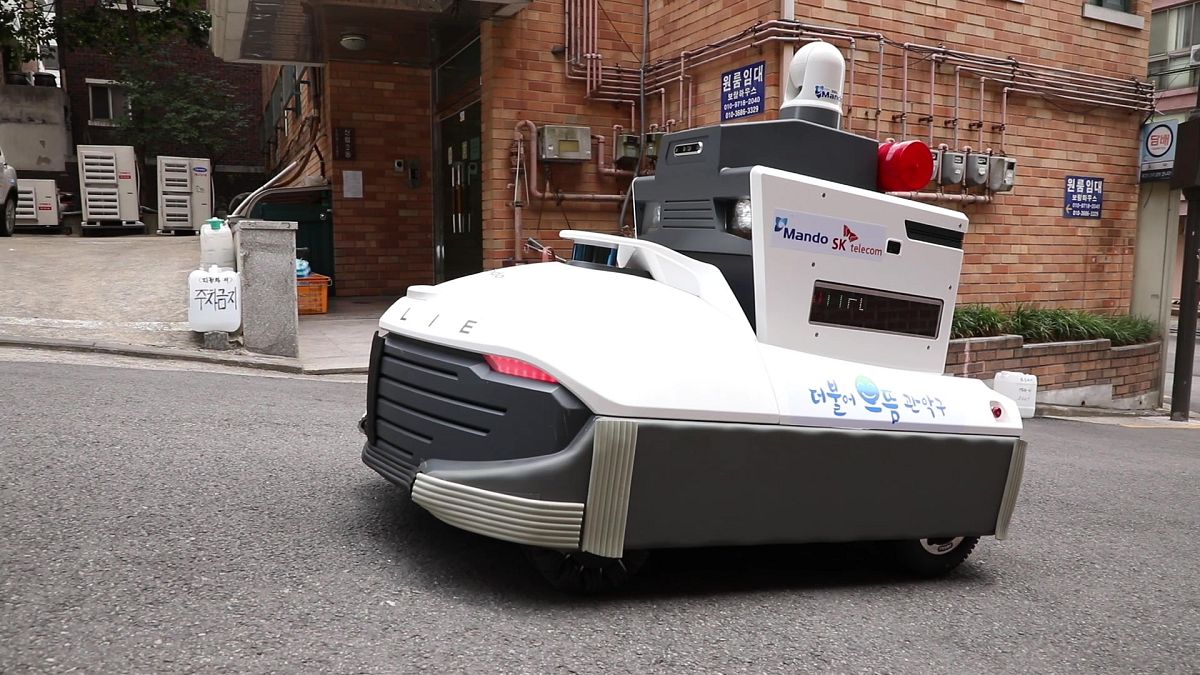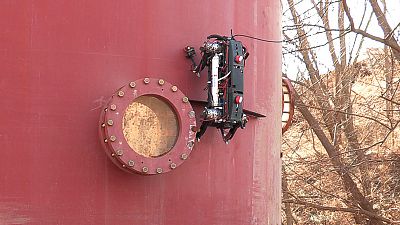The hi-tech patrol robot is being deployed in a neighbourhood where many women live alone and can feel unsafe at night.
In a narrow alley in Seoul, South Korea, a drunken man has fallen asleep on the pavement. A robot on wheels slowly approaches him and tries to wake him up.
"Sir, it's dangerous if you sleep here. Let me help you get home safely," says the robot. Shortly after, a police car arrives, lights flashing, and two officers drive the man away.
The patrol robot, called "Goalie," is South Korea’s first urban patrol robot. It’s designed to keep people safe on the streets, day and night, by communicating remotely with a control centre and alerting people to danger.
It essentially works like a "moving surveillance camera" that can inspect the blind spots of fixed CCTV cameras, its developer HL Mando told Euronews Next.
The bot, which weighs around 300 kg, drives autonomously and avoids pedestrians and obstacles using satellite navigation and remote sensing technology such as Lidar (light detection and ranging). It can also patrol at night using thermal imaging.
"The footage and sound that the robot monitors is transmitted via wireless communication (5G) to the control centre," said Young-ha Cho, senior researcher at HL Mando.
"When the robot sees a dangerous situation or hears a sound like 'help me,' the control centre operates the robot to move there and can check whether it is really a dangerous situation or not".
The case of the inebriated man sleeping on a pavement was first reported on by a South Korean newspaper, while footage shared by its developer shows the robot in action in a public park, blasting a siren when a toddler starts climbing a fence.
The robot also aims to make women feel safer at night when they’re walking on their own. In fact, Goalie is being rolled out in a residential part of Seoul that has the country’s highest share of women living alone.
Safety and privacy concerns
Right now, the hi-tech patrol robot is only allowed to operate alongside a human - and it has faced a few regulatory challenges over safety and privacy concerns.
According to HL Mando, the footage filmed by the robot is not stored - only livestreamed - and its communications with the control centre are encrypted, to comply with South Korea’s Personal Information Protection Act.
"Privacy issues are very important and sensitive in South Korea," Cho said.
"When the robot is patrolling, we are required to notify people near the robot that we are monitoring them. The patrol time windows should also be made public before the operation".
Goalie is technically not allowed to operate under South Korea’s current laws.
National regulations indeed restrict autonomous robots from operating on roads, sidewalks, and parks - and they cannot store video nor audio, meaning there are many obstacles to them accumulating data.
However, Goalie was granted conditional permission for test operations thanks to a so-called regulatory sandbox.
"It’s difficult to decide whether to ease an existing regulation, but it’s relatively easier to agree to test new technology in restricted circumstances," said Minho Lee, a senior research fellow at the Korea Institute of Public Administration.
"The regulatory sandboxes first came from the UK where they’re only used within the fintech industry, but in South Korea, we use this system across all industries," he explained.
Accompanied by staff
Lee warned that too many restrictions can make it hard to test a technology’s potential - and defeat the purpose of the regulatory sandbox system.
For example, Goalie currently needs to be accompanied by staff at all times, even though it’s designed to drive by itself and eventually replace human patrol officers.
Lee added that this kind of red tape could hurt start-ups, which cannot afford the time and money to slog through it.
"It took almost half a year to get permission from the government, and it was not easy to satisfy all their requirements," HL Mando’s Cho said of Goalie’s rollout.
South Korean authorities are now working on new regulations together with robot developers, academics and legal experts that - if approved and complied with - could scrap the need for a sandbox system altogether, Cho said.
"I hope this new regulation is made as soon as possible," he said.
For more on this story, watch the video in the media player above.



